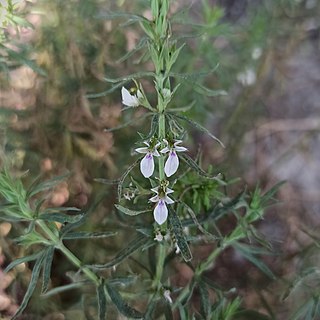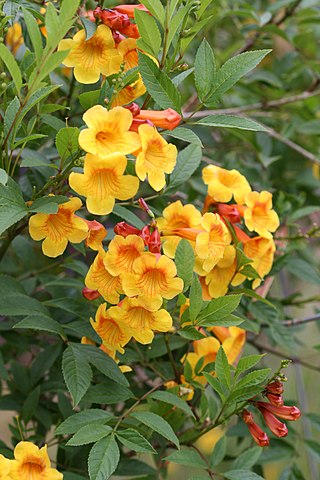
Bignoniaceae is a family of flowering plants in the order Lamiales commonly known as the bignonias or trumpet vines. It is not known to which of the other families in the order it is most closely related.

Tecoma is a suburb in Melbourne, Victoria, Australia, 35 km east from Melbourne's central business district and 1 km west of Belgrave, located within the Shire of Yarra Ranges local government area. Tecoma recorded a population of 2,064 at the 2021 census.

Tecoma railway station is located on the Belgrave line in Victoria, Australia. It serves the eastern Melbourne suburb of Tecoma, and opened on 1 February 1924.

Tecoma is a genus of 14 species of shrubs or small trees in the trumpet vine family, Bignoniaceae. Twelve species are from the Americas, while the other two species are African. The American species range from the extreme southern United States through Central America and the Antilles south through Andean South America to northern Argentina. The generic name is derived from the Nahuatl word tecomaxochitl, which was applied by the indigenous peoples of Mexico to plants with tubular flowers. Trumpetbush is a common name for plants in this genus.
Yellow bell is a common name for several plants with yellow flowers and may refer to:

Pandorea is a genus of nine species of flowering plants in the family Bignoniaceae and is native to Australia, Malesia, New Guinea and New Caledonia. Plants in the genus Pandorea are mostly woody climbers with imparipinnate leaves arranged in opposite pairs, flowers in groups with tube-shaped flowers, and winged seeds.

Pandorea jasminoides, also known by the common names bower of beauty and bower vine, is a species of flowering plant in the family Bignoniaceae and is endemic to eastern Australia. It is a woody climber with pinnate leaves that have three to nine egg-shaped leaflets, and white or pink trumpet-shaped flowers that are red and hairy inside. It is also grown as an ornamental.

Tecoma capensis, the Cape honeysuckle, is a species of flowering plant in the family Bignoniaceae, native to southern Africa. Despite its common name, it is not closely related to the true honeysuckle.

Tecoma stans is a species of flowering perennial shrub in the trumpet vine family, Bignoniaceae, that is native to the Americas. Common names include yellow trumpetbush, yellow bells, yellow elder, ginger Thomas. Tecoma stans is the official flower of the United States Virgin Islands and the floral emblem of The Bahamas.

The white-bellied sunbird, also known as the white-breasted sunbird, is a species of bird in the family Nectariniidae. It is found in Angola, Botswana, Democratic Republic of the Congo, Eswatini, Malawi, Mozambique, Namibia, South Africa, Tanzania, Zambia, and Zimbabwe.

Pandorea pandorana, commonly known as the wonga wonga vine or wonga-vine, is a species of flowering plant in the family Bignoniaceae and is native to Australia, Malesia and the southwestern Pacific region. It is a woody scrambler or climber with pinnate leaves, juvenile leaves differing from those of mature plants. The flowers are tubular or funnel-shaped and white with purple markings and the fruit are capsules containing winged seeds. It is easy species to germinate and is a popular garden plant. Common cultivars include the yellow-flowered P. 'Golden Showers', the white-flowered P. 'Snowbells', and the pinkish P. 'Ruby Belle'. The wood was used in making spears for woomeras in the Central and Western deserts.

Teucrium cubense is a species of flowering plant in the mint family known by the common names small coastal germander and dwarf germander. It is native to a section of the Americas that includes the southwestern - south-central United States, parts of the Caribbean, Mexico, Costa Rica, and southern South America. In general, the plant has lobed leaves and a flower corolla with a broad lower lobe and smaller lateral lobes. The flower may be white or blue-tinged with purple speckles.

Pandorea doratoxylon is a species of woody vine in the family Bignoniaceae and is endemic to Australia. The species was first formally described in 1927 by John McConnell Black who gave it the name Tecoma doratoxylon in Transactions and Proceedings of the Royal Society of South Australia. In 1937, Black changed the name to Pandorea doratoxylon.

Tecoma × smithii, "Orange Bells", is a hybrid flowering plant in the genus Tecoma. It was first described by W. Watson in London, 1893. It is a shrub growing to 2.4–3.6 m (8–12 ft) in height.

Tecoma fulva is a species of flowering plant native to South America. In the past, several species have been named, which are more recently considered to be subspecies.
Tecoma beckii is a species of flowering plants native to Bolivia. Unlike some other Tecoma species, the leaves are simple.

Tecoma castanifolia is a species of flowering plant native to Ecuador and Peru. Unlike some other Tecoma species, the leaves are simple.
Tecoma tenuiflora is a species of flowering plants native to Bolivia and Argentina. It is thought to be closely related to T. rosifolia, and hybridizes with T. stans and T. beckii.

Pandorea floribunda is a species of flowering plant in the family Bignoniaceae and is endemic to eastern Australia. It is similar to Pandorea pandorana but the leaflets are egg-shaped, 30–80 mm (1.2–3.1 in) long and 15–50 mm (0.59–1.97 in) wide and the flowers are pale yellow to cream-coloured.

Pandorea linearis is a species of flowering plant in the family Bignoniaceae and is endemic to Queensland. It is similar to Pandorea pandorana but has nine to thirteen linear leaflets, the lateral leaflets 11–42 mm (0.43–1.65 in) long and 1.5–6 mm (0.059–0.236 in) wide.
















